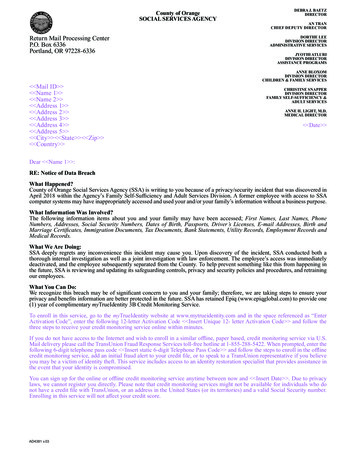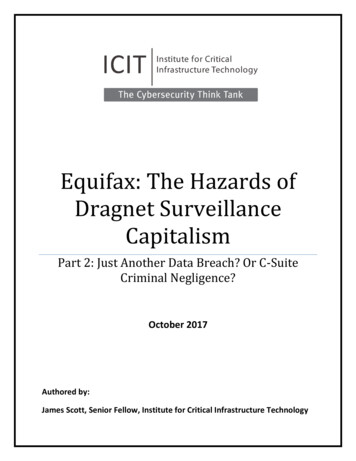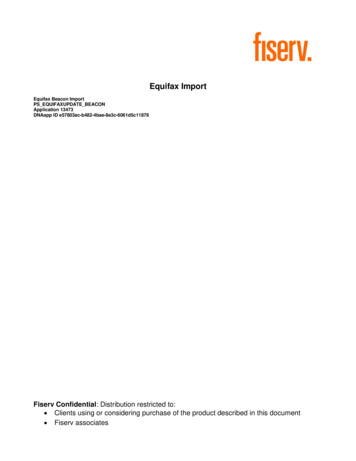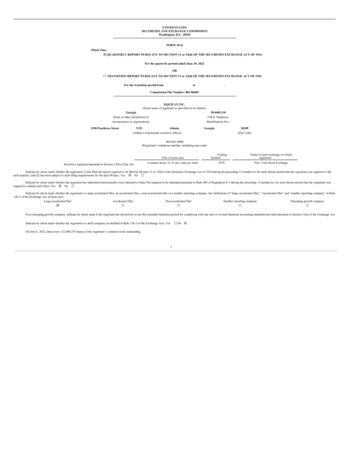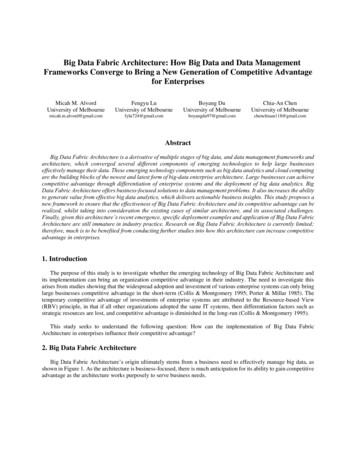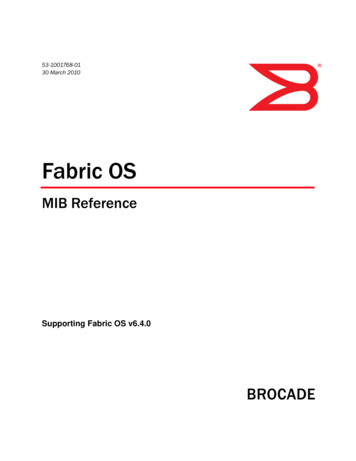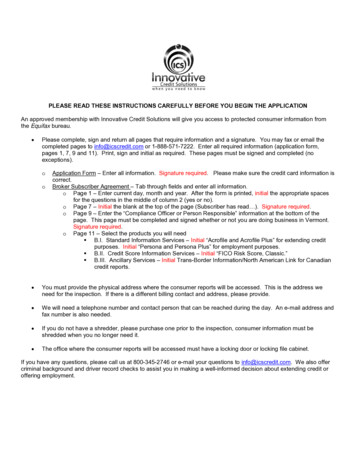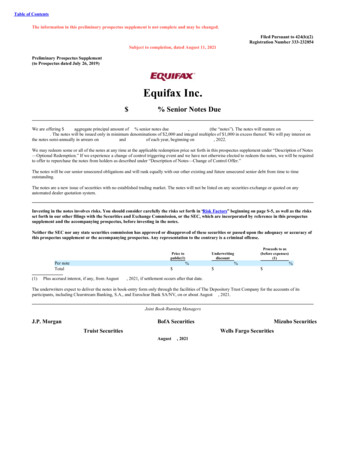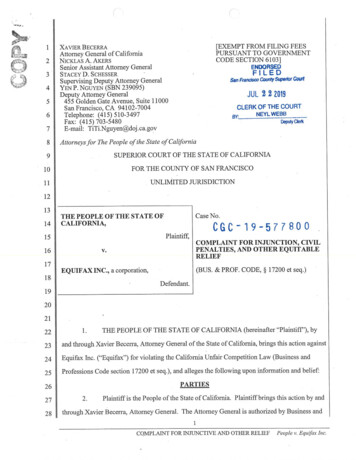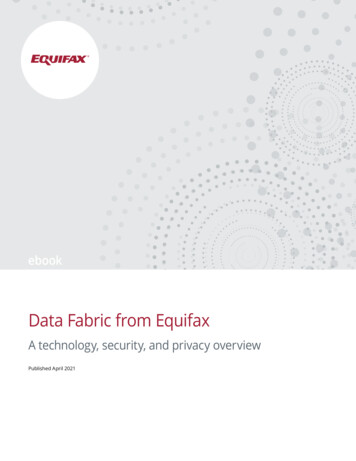
Transcription
ebookData Fabric from EquifaxA technology, security, and privacy overviewPublished April 2021
ContentsWho should use this document. 3Data Fabric migration overview. 3Data pipelines. 4Analytical services. 5Catalog services. 5Data privacy and protection. 6Visual example.12
Who should use this documentThis document is intended for Equifax customers and partners to gain a deeperknowledge about the technology used to ingest, store, and ultimately deliverproducts and solutions to customers and partners from the Data Fabric. This is apart of the overall cloud-native transformation at Equifax.Business leaders are encouraged to learn more about the business transformationunderway at Equifax while technology leaders can reference this document tolearn about the stages, components, and data privacy inherent in the Data Fabricfrom Equifax.Data Fabric migration overviewAs part of the Equifax cloud-native transformation, we are migrating data,products, applications, and networks to the cloud for greater flexibility, scale,reliability and system insights.As the final component of a multi-year journey, the data migration is designed withtesting and validation at the core. Once in the cloud, our vast array of differentiateddata sources available will be housed on a single platform known as the DataFabric, logically separated with strict compliance and data governance controls.Some of these data sources, including employment and income and digitalidentity, are only available from Equifax.The Data Fabric is a cloud-native enterprise data management platform thataggregates all data received by Equifax into a single environment, deployedregionally on the Google Cloud Platform (GCP). This data is subsequently madeavailable to customers in the form of products solutions, such as scores, models,and attributes. Our Data Fabric generally consists of two integrated capabilities —data pipelines and analytical services. Underlying governance capabilities knownas catalog services enable Data Privacy and Protection (DPP) to be an integralcomponent of the Data Fabric.-3-Who should use this documentand Data Fabric migration overview
Data pipelinesThe Data Fabric onboards and manages data assets ingested by Equifax by providinga set of API-based services through the data lifecycle stages of Preparation,Ingestion, Keying and Linking, Journaling, and Purposing. Data Preparation and Ingestion are the services for receiving and preprocessing raw data assets by applying data quality rules and converting data intoa format that can be further processed and analyzed. Keying and Linking are the operations that identify the entity (e.g., person,business, or other) to which specific data should be associated. Each entity has aunique key assigned to it and expressed as a numeric identifier. This key is addedto the specific data during this stage, which then enables disparate data to belinked to the same entity. Journaling is the service that receives and stores the prepped and ingesteddata. This stage is called Journaling because the specific technique employed tostore data is to essentially record sequential observations (i.e., comparable tojournal entries). Journaling is responsible for persisting new observations and forcombining new observations with existing master observations. For example, anobservation could be a new address associated with a person. Purposing is the service that receives journaled data and applies rules relating toa specific use case. Once the rules are applied, the resulting data is available to beviewed or extracted. The Purposing processes are typically executed shortly afterdata is journaled, with the goal of combining any new observations with otherexisting, historical observations, typically at a person or entity level.-4-Data pipelines
Analytical servicesThe Data Fabric includes a set of analytical services that enables business users,such as data stewards and data scientists, to analyze and create insights usingdata from the analytical environment (as described in more detail below), which isessentially a collection of snapshots taken during the data lifecycle stages.Catalog servicesThe Data Fabric includes a set of catalog services to record information about thedata assets in Data Fabric, which is also referred to as metadata or “data aboutdata.” Catalog services are designed to record, track, and manage information aboutthe data assets, the transformation operations performed against the data, and thedestinations of any copies or extracts made of the data.The catalog services consists of two components:1. a GCP-hosted component called the Catalog thatis an integrated part of the data fabric2. a licensed third-party solution called Collibra.The Catalog is focused on supporting the operational needs of the Data Fabric, whileCollibra is focused on the broader, corporate-wide metadata requirements. Thecombination of these components provides a comprehensive view on Data Fabricdata assets. In the future, these components will become integrated. This diagramillustrates the previously described Data Fabric capabilities:Data Fabric from EquifaxIngested DataDATA PIPELINESANALYTICS ng singCustomerDATA PRODUCTSTo ProductsData Intel and Catalog ServicesAs a frame of reference, the following chart compares the components of aphysical manufacturing warehouse with the Data Fabric. The warehouse receivesshipments of parts from various sources, records, and categorizes them. The partsare then unpacked, sorted, and properly stored in the warehouse to facilitate themanufacturing process. In some cases, the parts may be picked, partially assembled,and then returned to the warehouse until needed. Ultimately, the parts are movedto the manufacturing floor and assembled into a finished product, which is thenpackaged and shipped to the customer’s destination.-5-Analytical services and Catalog services
Physical manufacturing warehouseDigital warehouse (Data Fabric)PartsIngestion of contributed dataData Preparation and Keying and Linking (e.g., cleansing,deduplication, keying and linking specific data)Partial assemblyRecording/CatalogingCatalog servicesWarehouseData Fabric data repositoriesFinal assemblyPurposing (e.g., data extraction, filtering, purposing)Transformation to a target format, including encryption anddata/file transfersPackaging and shippingData privacy and protectionFour key call-outs related to Data Privacy are covered in this section:1) Data isolation (or segregation)2) Keying and Linking capabilities3) ‘Least privilege’ applied to analytical services4) Data retentionData isolation (or segregation)Historically, our applications were built for specific purposes and were embeddedwith hard-coded business logic. This strategy created a complex legacyinfrastructure that was resource-intensive to maintain. The Data Fabric solves theseproblems by storing the data assets into a single, connected platform designed withthe technology allowing for data isolation — as required by our legal, contractual orregulatory obligations and other business requirements. Additionally, it offers theflexibility to easily implement and modify business logic on the platform.GCP, like aspects of our legacy infrastructure, is a multi-tenant environment withdata kept logically separated from users based on approved access levels. For dataresidency and performance purposes, data is stored in regional repositories basedon the geographical use case (e.g., United States, United Kingdom, or Australia). TheData Fabric is hosted on the GCP and is also designed to support multi-tenancy,meaning that it can process and house data assets from different sources orcustomers while maintaining logical separation between these assets unless anintentional decision to combine the data assets is made.Domains and subdomainsMulti-tenancy has been implemented in the Data Fabric on multiple levels asrequired by our business by utilizing domains and subdomains. A domain is a broadcategory of data that we ingest (e.g., Credit, Employment, Telecommunications,Wealth), and a subdomain is a subcategory of the domain. In other words, a domainis a collection of subdomains and a subdomain may only belong to one domain. Anexample of a subdomain of the employment domain would be Payroll. Each domainstores data in its own storage repository. (Please see the retention section later inthis document for more details on data storage.)In the context of domains and subdomains, the Data Fabric helps solve problems withthe legacy infrastructure because our business is able to define and validate rulesfor their domains and subdomains. These teams can easily implement and modifybusiness logic at the domain or subdomain level. In the end, our Data Fabric willconsist of minimal hard-coded rules, relying on the business logic rules applied tothe domain or subdomain level.-6-Data privacy and protection
Data pipelinesConceptually, one can consider a domain as a dedicated pipe that maintains dataseparate from other domains until business logic is applied to combine data fromdifferent domains. The subdomains allow for further categorization within domains. Data remains in its assigned domain through the data pipelines and will only beallowed to mix with data in other domains using approved purposing rules. Logical separation relies on access controls and devaluation to prevent comingling of data assets that could potentially violate our legal, contractual orregulatory obligations and other business requirements. The following rules areconsistent with our security framework:– We require data contributors to encrypt their data using the Data Fabric’s publickey. The data is then ingested and decrypted using the Data Fabric’s private key.(Similarly, data that is transferred from the Data Fabric is encrypted with therecipient’s public key.) All data reposed in Data Fabric is encrypted using GCP native encryption. The most sensitive contributed data is also encrypted at the field level usingour Barricade library, a tool which allows us to manage the encryption anddecryption of data directly, using GCP supported cryptographic libraries. Finally, the most sensitive contributed data is also encrypted at the field level.– Data within subdomains of a particular domain is encrypted with the same key.Data in a particular subdomain is encrypted with a key that is different fromdata in a subdomain in another domain. In other words, for data segregation,data within each subdomain of a particular domain is considered “friendly”data, Access to the key needed to decrypt the data in each domain is controlledthrough access groups.– All of the Data Fabric and GCP Services are secured using internal Identity andAccess Management (IAM) roles that are specific to the type of account beingused and the role that account is intended to serve. Service accounts are not usable by end users and have access tokensprotected and automatically managed by Google Key ManagementService (KMS). Service account permissions apply to each stage in the data lifecycle and areprovisioned by the Equifax Security’s IAM team. User account access is centrally managed with roles assigned by Equifax andutilizes multi-factor authentication. Data in the pipelines is generally accessible only through service accounts,meaning there is no human equivalent with access to the data.1 While access to data environments by system operators or administratorsis allowed, these accounts do not have access to the encryption keys and donot have direct access to unencrypted data.-7-Data privacy and protection
The following diagram illustrates the logical separation of domains within the datapipelines. In this illustration, data for each business domain (e.g., Credit, Utility,Employment) are isolated from other domains using logical data pipelines.Data Fabric from EquifaxDATA PIPELINESANALYTICS PrepIngestionKeying sToolsDATA PRODUCTSJournalingPurposingTo ProductsData Intel and Catalog ServicesAnalytical Services (Analytical Environment)Data that is copied over to Analytical Services will reflect its original logicalseparation. Each application utilizing the data will be approved to access data setsbased on a governance review. In some cases, where review has approved the use,data from different data sets may be accessed by the same application. As explainedbelow, the principle of least privilege is followed for all data access implementations.Keying and Linking capabilitiesKeying and Linking is a critical service in the data pipelines that facilitates journaling,purposing, and ultimately the delivery of products and solutions to Equifaxcustomers and partners. Keying and Linking is the process of identifying the entitythat information is associated with and assigning a unique key to it. Keys areassigned at the entity level, and an entity can be identified across domains using a“combined key” when allowed by business rules.Here is an example of Keying and Linking:John Smith, 123 main st, NY, SSN123456789Key: 75629AndJohn Smith, SSN 123456789,Acct 8765432, Payment 100.00Key: 75629By using the key “75629,” these two data sets can be linked together and associatedwith a single entity (in this case a person). These two data sets could be from thesame data source or different data sources within one or more domains. They arekeyed and linked based on which rules are implemented for the Data Fabric at thebusiness unit or regional level.-8-Data privacy and protection
Keying and Linking functional designEach data source ingested into the Data Fabric requires defined rules to beorchestrated at the field level to specify how annotated fields can participatein the Keying process. This is defined in a Keying and Linking profile which is aconfiguration to prescribe which Keying and Linking operations are available forthe data received. In practical terms, this means that the data elements used for akey are defined specifically for the use case, not generically across all data withinthe Data Fabric. This allows our business to utilize a common capability with theflexibility to define specific rules for each respective use case.The following diagram illustrates the functional design of the Keying andLinking process:Keying & LinkingCONFIGURABLE ENTITY REPOSITORYUtility KeyProduct1Product2Find EntityEmploymentDomainCredit KeyConfigurable RulesUtilityDomainConfigurable RulesCreditDomainIngest oymentKeyCombinedKeyConsult Configurable FieldAnnotations & ProfilesSub-Domain1PurposedView 1Sub-Domain2PurposedView 2Sub-Domain3PurposedView 3Data CatalogThe configurable annotations are combined with the profile information for eachsource. This drives what each source will contribute to the Keying and Linkingprocess. The profile information contains a set of configuration options thatprescribe what each source can do in the keying process. Additionally, it points tothe rule sets to be applied when each source is processed (i.e., which fields withinthe data source can be used).The following diagram illustrates how the annotations and profiles are used:-9-Data privacy and protection
The Keying and Linking process is important and enables us to offer a uniquecapability because it allows for entity resolution across data sources when dataelements are inconsistent. In other words, the Data Fabric can identify an entitybased on many combinations of data elements instead of a predetermined list ofrequired fields, which is adaptable to meet our unique business andregulatory environments.Least privilege applied to analytical servicesAs referenced above, analytical services provided by the Data Fabric enable our dataanalysts to carry out comprehensive analysis across large amounts of data to gaininsights that benefit our customers. Unlike the data pipelines that are only accessedwith service accounts, users like data stewards and data scientists naturally accessthe data in analytical services and, therefore, require us to implement the conceptof least privilege.2There are two concepts that come together in the Data Fabric which enable granularaccess to data: tables and views. In general, tables represent the physical storage ofdata, whereas views are access rights that enable users to view only certain portionsof the physical data stored in tables. Because portions of data do not need to beduplicated for different uses, views enable us to better adhere to our data retentiongovernance objectives. Views can also be defined at the most granular level: the dataelement. Users can create as many views as necessary to support their businessobjective, which are each subject to their own access entitlement. Views, therefore,also fulfill the least privilege requirements.The following diagram illustrates the governed data access in theanalytics environment:ANALYTICS PROJECTSProject 1TABLESVIEWSData AView (A,B)Data BView (ABC)Data CData CData DData DData EData EData StewardsData accessed and copiedbased on approved entitlementsProject 2Data Scientists/AnalystsEntitlementsmanagedusing EquifaxAccess ManagerProject 3Fraud AnalystsProject 4K&L Analysts- 10 -Data privacy and protection
The Data Fabric ultimately provides more granular access control than the legacyon-premise environment. The chart below illustrates how data access workswith the legacy and new Data Fabric environments:LegacyData Fabric analyticsRemarksProject levelentitlementsManaged at Application levelManaged through AccessManagerThe Data Fabric enablesstandardized accessmanagement.Data entitlementRole-based access control(RBAC)Functional equivalent of RBACusing ‘views’The same user experienceis provided in bothenvironments.Analytics toolsentitlementsOpen access across projectsallowing data movementacross projectsData movement only within aprojectThe Data Fabric providesbetter control over datamovement.Purpose-basedgovernanceLeverage tool (Privacera)and manual audits; datamovement is monitoredAt the time of publication, this isthe same as the legacy method.A new single solutionis currently underdevelopment.Data retentionThe Data Fabric reposes data in different locations as represented by this view:BusinessApplicationsEquifaxCorporate SystemsCustomer(ie, D&D, Consent, Billing, etc)AnalyticsContributedDataData PrepIngestionRAWLicensedDataINGESTEDKeying& LinkingAttributes& MASTER ENTITIESRegulatorsNON-PURPOSED JOURNALSCATALOG SERVICESENTERPRISE DATA STORESDATA FABRICConfigurable Business RulesEach storage repository is a GCS bucket, a BigTable instance, or a BigQuery data set.A GCS bucket can be considered roughly equivalent to a file folder, and a BigTableinstance or a BigQuery data set can be considered equivalent to a database.All data assets in the Data Fabric can be broadly classified into (i) a “system ofrecord,” which is in the data pipelines and (ii) snapshots and copies of the systemof record that are carried over to analytical services. (With respect to the viewsmentioned above, they are views of the snapshots or copies carried over toanalytical services.) The Data Fabric can implement retention policies in each ofthe repositories based on the two classifications (e.g., system of record with oneretention period and a snapshot or copy another) in compliance with the EquifaxGlobal Retention Policy.Though retention periods can be implemented at the system level in each repositoryinstance, the Data Fabric is designed to expect retention policies and periods to bemanaged by data stewards using meta data services within the data catalog.- 11 -Data privacy and protection
Visual exampleThe diagram below shows a high-level flow of data in the Data Fabric. The stepsprovide an example of how data contributed from a credit data furnisher flowsthrough the Data Fabric platform.Data Fabric from EquifaxIngested DataCustomerDelivery ChannelsBusiness ApplicationsDATA FABRICProducts12Data PrepIngestionKeying& LinkingRAWMASTER ENTITIESINGESTED3Journals45PurposingAttributes& OG CTSNo User Level Access1 Data is received from a data furnisher and routed to Data Fabric for prep andingestion. At this stage the data is put into the “Credit” domain and “ConsumerCredit” subdomain based on the data source (i.e., the credit data furnisher).2 Once ingested, the data is keyed based on the configuration for the furnisher,credit domain, and consumer credit subdomain.3 The keyed data is then passed to the journaling stage and the keys areused to update the credit domain journals for the entities present in thefurnished data.4 One purpose for the credit domain is consumer credit reports; data goesthrough the credit reporting purposing process to aggregate data necessaryto deliver a credit report. Data is also used for analytic projects, so the data ispassed to the analytical environment.5 Data is then used by Attributes, Modeling and Product/ Business Application toprepare and deliver the credit report to the customer.6 Purposed data gets transferred to the analytical environment for analyticsprojects based on approved use cases.7 Data in the analytical environment is accessible by users based on job roleusing the tables and views concept.Learn more about our cloud-native strategy and findadditional resources to address your questions.1 Limited human accounts are utilized to maintain data integrity and handle error-correction. These accounts are monitored and limited.2 In general, ‘least privilege’” means that a user is given access only to the data needed for that user to perform their job.Copyright 2021, Equifax Inc., Atlanta, Georgia. All rights reserved. Equifax is a registered trademark of Equifax Inc. 21-105800Managed Access
data sources available will be housed on a single platform known as the Data Fabric, logically separated with strict compliance and data governance controls . Some of these data sources, including employment and income and digital identity, are only available from Equifax . The Data Fabric is a cloud-native enterprise data management platform that

